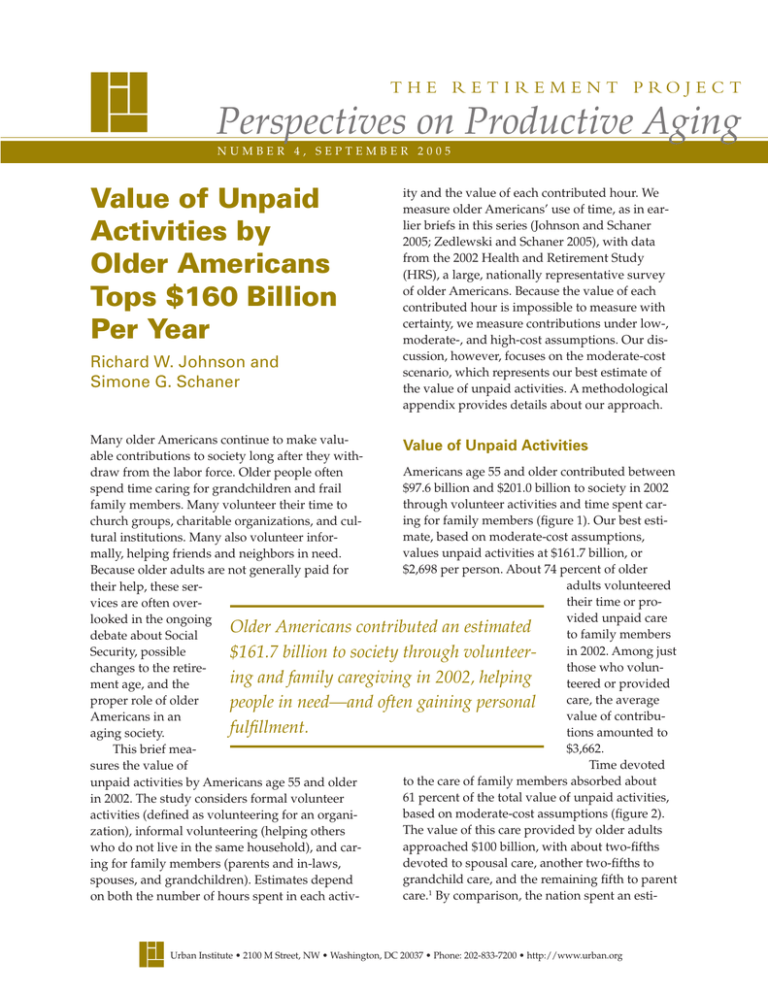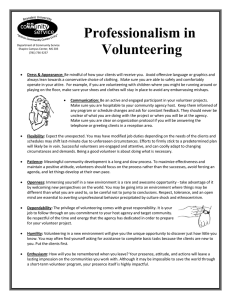Perspectives on Productive Aging Value of Unpaid Activities by
advertisement

T H E R E T I R E M E N T P RO J E C T Perspectives on Productive Aging NUMBER 4, SEPTEMBER 2005 Value of Unpaid Activities by Older Americans Tops $160 Billion Per Year Richard W. Johnson and Simone G. Schaner ity and the value of each contributed hour. We measure older Americans’ use of time, as in earlier briefs in this series (Johnson and Schaner 2005; Zedlewski and Schaner 2005), with data from the 2002 Health and Retirement Study (HRS), a large, nationally representative survey of older Americans. Because the value of each contributed hour is impossible to measure with certainty, we measure contributions under low-, moderate-, and high-cost assumptions. Our discussion, however, focuses on the moderate-cost scenario, which represents our best estimate of the value of unpaid activities. A methodological appendix provides details about our approach. Many older Americans continue to make valuValue of Unpaid Activities able contributions to society long after they withAmericans age 55 and older contributed between draw from the labor force. Older people often $97.6 billion and $201.0 billion to society in 2002 spend time caring for grandchildren and frail through volunteer activities and time spent carfamily members. Many volunteer their time to ing for family members (figure 1). Our best estichurch groups, charitable organizations, and culmate, based on moderate-cost assumptions, tural institutions. Many also volunteer inforvalues unpaid activities at $161.7 billion, or mally, helping friends and neighbors in need. $2,698 per person. About 74 percent of older Because older adults are not generally paid for adults volunteered their help, these sertheir time or provices are often overvided unpaid care looked in the ongoing Older Americans contributed an estimated to family members debate about Social in 2002. Among just Security, possible $161.7 billion to society through volunteerthose who volunchanges to the retireing and family caregiving in 2002, helping teered or provided ment age, and the care, the average proper role of older people in need—and often gaining personal value of contribuAmericans in an fulfillment. tions amounted to aging society. $3,662. This brief meaTime devoted sures the value of to the care of family members absorbed about unpaid activities by Americans age 55 and older 61 percent of the total value of unpaid activities, in 2002. The study considers formal volunteer based on moderate-cost assumptions (figure 2). activities (defined as volunteering for an organiThe value of this care provided by older adults zation), informal volunteering (helping others approached $100 billion, with about two-fifths who do not live in the same household), and cardevoted to spousal care, another two-fifths to ing for family members (parents and in-laws, grandchild care, and the remaining fifth to parent spouses, and grandchildren). Estimates depend care.1 By comparison, the nation spent an estion both the number of hours spent in each activ- Urban Institute • 2100 M Street, NW • Washington, DC 20037 • Phone: 202-833-7200 • http://www.urban.org FIGURE 1. Value of Unpaid Activities by Americans Age 55 and Older, 2002 250 201.0 Billions of dollars 200 161.7 150 100 97.6 50 0 Low cost Moderate cost High cost Source: Authors’ estimates Note: Estimates are based on a sample of 16,811 adults age 55 and older in the 2002 HRS. See the methodological appendix for an explanation of different cost scenarios. FIGURE 2. Composition of Value of Unpaid Activities at Older Ages, Under Moderate-Cost Assumption, 2002 Spousal care 24% Formal volunteering 28% Parent care 13% Informal volunteering 11% Grandchild care 24% Total Value: $161.7 billion Source: Authors’ estimates Note: Estimates are based on a sample of 16,811 adults age 55 and older in the 2002 HRS, under moderate-cost assumptions as explained in the methodological appendix. 2 T H E R E T I R E M E mated $135 billion on formal long-term care services for the aged in 2004 (CBO 2004). Older Americans contributed $44.3 billion through formal volunteer activities in 2002, and another $17.8 billion by volunteering their time through informal channels. These estimates are based on moderate-cost assumptions about the value of each contributed hour. Volunteer activities generate a value lower than caregiving activities because caregiving is more time intensive. However, older people are more likely to spend at least some time volunteering, through formal or informal channels, than serving as caregivers. N T P R O J E C though women spend more time than men in each of the five activities we consider, the gender difference is most pronounced for the care of grandchildren. Women supply nearly 70 percent of all grandchild care provided by older family members. The value of contributions by older Americans declines with age, as the likelihood of spending any time on volunteer activities or caring for parents and grandchildren falls. Under the moderate-cost scenario, the annual value of unpaid activities declines from $2,970 per person age 55 to 64, to $2,055 per person age 75 and older. However, unpaid activities are substantial even at quite advanced ages, totaling $32.1 billion in 2002 for those age 75 and older. Among older adults who contribute time to organizations, family, friends, and neighbors, the per capita value at age 65 and older exceeds the value at age 55 to 64, because those who partici- Variation by Gender and Age Older women devote more time to unpaid activities than older men, contributing $2,968 on average in 2002 under moderate cost assumptions, compared with $2,363 for men (table 1). Al- TABLE 1. Value of Activities at Older Ages, Under Moderate Cost Assumption, by Gender and Age, 2002 Gender Age All Male Female 55–64 65–74 75+ Total Value of Unpaid Activities ($ billions) All Formal volunteer Informal volunteer Grandchild care Parent care Spousal care 161.7 44.3 17.8 39.2 20.9 39.5 63.3 18.9 7.7 11.9 7.4 17.5 98.4 25.4 10.1 27.3 13.5 22.1 78.3 19.1 9.6 23.6 16.3 9.6 51.3 14.5 5.5 11.6 4.3 15.5 32.1 10.7 2.7 4.0 0.3 14.3 Per Capita Value of Unpaid Activities ($) All adults Employed adults Nonemployed adults Adults engaged in unpaid activities 2,698 2,551 2,793 3,662 2,363 2,108 2,594 3,090 2,968 3,059 2,924 4,156 2,970 2,589 3,678 3,564 2,857 2,471 3,016 3,785 2,055 2,136 2,048 3,701 Total Value of Paid Employment ($ billions) 767.8 497.2 270.5 655.0 101.5 11.3 Source: Authors’ estimates. Note: Estimates are based on a sample of 16,811 adults age 55 and older in the 2002 HRS, under moderate-cost assumptions as explained in the methodological appendix. Components do not always sum to totals because of rounding. 3 T pate beyond age 65 devote a lot of time to unpaid activities. The oldest Americans are especially likely to provide spousal care, which is quite time intensive. The value of paid employment at older ages dwarfs the value of unpaid activities, except for those age 75 and older. Valued at the wages received by workers, paid employment at age 55 to 64 reached $655.0 billion in 2002, more than eight times the value of unpaid activities (under moderate-cost assumptions). Even at age 65 to 74, when most people have stopped working, unpaid activities generated only half the monetary value of paid employment. Although older adults who are not employed devote more on average to unpaid activities than those working for pay, worker contributions are sizeable. At age 55 to 64, for example, workers contributed $2,589 in unpaid activities in 2002, on average, compared with $3,678 for nonworkers. Methodological Appendix We estimate the worth of unpaid activities by Americans age 55 and older in 2002 by computing the total number of hours they devote to formal volunteering, informal volunteering, and caregiving and by assigning a value to each hour. The HRS collects data on various activities, but often uses different reference periods and hour thresholds. The survey asks about hours spent during the past 12 months volunteering for an organization and helping others who did not live with the respondent, hours spent caring for spouses during the past month (or the last three months of life for recently deceased spouses), and hours spent caring for grandchildren, parents, and in-laws during the past two years (if greater than 100).2 We annualize caregiving hours. Note that time devoted to grandchild and parent care for those who spend fewer than 100 hours over a two-year period are not included in our estimates. Table A1 reports the hourly values we assign to each activity. Under the moderate-cost scenario, we set the value of each hour of formal volunteering equal to the average nationwide wage paid to office and administrative support workers (because these activities often involve clerical work) and the value of informal volunteering equal to the federal minimum wage (because informal volunteer activities generally require few skills). We set the value of grandchild care equal to the average wage paid to child care workers who are not self-employed. The hourly value of parent care and spousal care equals the average wage paid to personal and home care aides. The high-cost scenario uses the average wage paid to community and social services workers to value formal volunteer activities. This amount exceeds the value used in the moderatecost assumption by about 24 percent, but roughly equals the value used by Independent Sector (2004) in 2002 to measure the worth of volunteer activities at all ages. The high-cost scenario sets the hourly value of informal volunteering equal to the average wage paid to office and adminis- Discussion Although precisely measuring the value of unpaid activities is impossible, our best estimate suggests that older Americans contributed $161.7 billion to society through volunteer activities and time spent caring for family members in 2002. The value of caregiving activities alone approached $100 billion. All of these activities entail significant social benefits, enhancing religious and cultural experiences, improving educational opportunities, and helping people in need. Often, unpaid activities also provide a sense of personal fulfillment to volunteers and caregivers. Our results highlight the importance of social contributions by older Americans, even when they do not work for pay. Much of the current Social Security reform debate emphasizes the economic cost of an aging population and the importance of encouraging work at older ages. But the debate generally ignores the significant unpaid activities undertaken by older Americans. Work at older ages is important and should be encouraged, but not at the expense of meaningful volunteer and caregiving activities. 4 TABLE A1. Assumed Hourly Value of Unpaid Activitities, by Cost Scenario, 2002 (Dollars) Formal volunteering Informal volunteering Grandchild care Spousal care Parent care Low Moderate High 5.15 5.15 5.15 5.15 5.15 13.41 5.25 8.32 8.07 8.07 16.65 13.41 8.32 8.07 8.07 Source: Authors’ assumptions, based on the federal minimum wage and BLS (2003). trative workers, and the value of caregiving at the same level as the moderate-cost scenario. Under the low-cost scenario, the hourly value of all unpaid activities equals the federal minimum wage. Hourly wage data come from the Occupational Employment Statistics survey, compiled by the Bureau of Labor Statistics and state employment agencies (BLS 2003). Bureau of Labor Statistics (BLS). 2003. “Occupational Employment and Wages 2002.” http://www.bls.gov/ news.release/archives/ocwage_11192003.pdf. Notes Johnson, Richard W., and Simone G. Schaner. 2005. “Many Older Americans Engage in Caregiving Activities.” Perspectives on Productive Aging Policy Brief 3. Washington, DC: The Urban Institute. Congressional Budget Office (CBO). 2004. “Financing LongTerm Care for the Elderly.” Washington, DC: Congressional Budget Office. Independent Sector. 2004. “Value of Volunteer Time.” http://www.independentsector.org/programs/research/ volunteer_time.html. The authors are grateful to Barbara A. Butrica and Sheila R. Zedlewski for valuable comments on an earlier draft of this report. Zedlewski, Sheila R., and Simone G. Schaner. 2005. “Older Adults’ Engagement Should be Recognized and Encouraged.” Perspectives on Productive Aging Policy Brief 1. Washington, DC: The Urban Institute. 1. An earlier estimate valued informal caregiving activities by adults of all ages at $196 billion in 1997 (Arno, Levine, and Memmott 1999). 2. For more information on the HRS, see http://hrsonline.isr. umich.edu. About the Authors Richard W. Johnson is a principal research associate and Simone G. Schaner is a research assistant in the Urban Institute’s Income and Benefits Policy Center. References Arno, Peter S., Carol Levine, and Margaret M. Memmott. 1999. “The Economic Value of Informal Caregiving.” Health Affairs 18(2): 182–188. 5 THE URBAN INSTITUTE 2100 M Street, NW Washington, DC 20037 Nonprofit Org. U.S. Postage PAID Permit No. 8098 Ridgely, MD Address Service Requested For more information, call Public Affairs: 202-261-5709 or visit our web site, http://www.urban.org. To order additional copies of this publication, call 202-261-5687 or visit our online bookstore, http://www.uipress.org. Perspectives on Productive Aging is a series of data and policy briefs focused on engagement activities among adults age 55 and older. The series is supported through a grant from Atlantic Philanthropies as part of their Ageing Programme, which seeks “to bring about lasting improvement in the lives of older adults and to transform how ageing is viewed and older persons are treated by society.” As America ages, older adults are getting more attention. Gone (or at least fading) is the stereotype of the retiree who is unable to work and who makes relatively few social contributions. Increasingly, older Americans are seen as a vibrant group with wisdom and energy to offer society and their families. Perspectives on Productive Aging will enhance the dialogue on the engagement of older Americans, documenting the current value of engagement among older adults and highlighting the best ways for society and policymakers to support and encourage the full engagement of older Americans. Perspectives on Productive Aging is part of the Urban Institute’s Retirement Project. Further information can be obtained at http://www.urban.org/retirement. THE URBAN INSTITUTE 2100 M Street, NW Washington, DC 20037 Copyright © September 2005 Phone: 202-833-7200 Fax: 202-293-1918 Copyright © September 2005. Permission is granted to reproduce this document with attribution to the Urban Institute. The views expressed are those of the authors and do not necessarily reflect those of the Urban Institute, its board, its sponsors, or other authors in the series.




